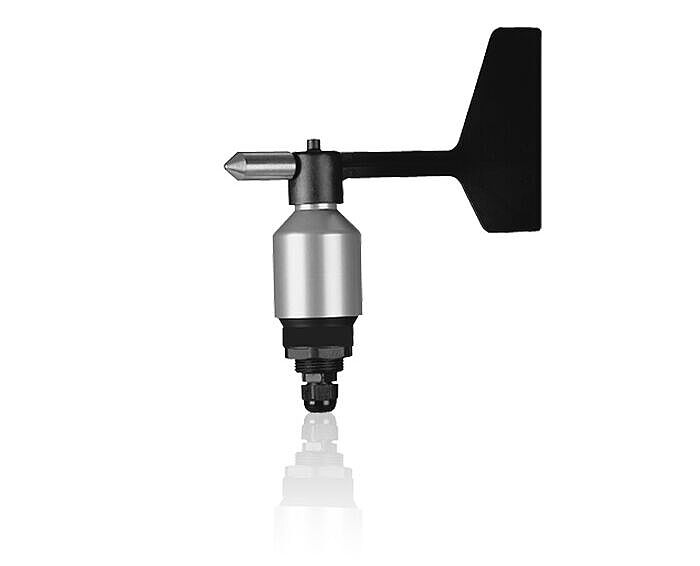
The Wind Direction Sensor is used to detect the horizontal wind direction. The data is transferred to the ISYGLT Master via the WSM-01E Module.
The Wind Direction Sensor is used to detect the horizontal wind direction and to convert it into electrical signals. The measured values are transmitted as electrical digital signals for processing in the ISYGLT system.
For winter operation, all devices are equipped with an electronically controlled heating system to prevent the ball bearings and outer rotating parts from freezing. The electrical supply of the wind sensor heating is carried out e.g. with our power supply unit.
When using mounting adapters (winch, traverse, etc.), a possible influence of turbulence must be taken into account.
Structure and mode of operation
The wind direction is detected by a low-inertia plastic wind vane whose ball-bearing axis is connected to a code disk. This code disk contains a Gray code which is scanned opto-electronically. Depending on the version, different resolutions of the wind directions are available (see technical data). The sectors resulting from the resolution start at wind direction N = 0° with sector-0 to sector-n. The outer parts of the device are made of corrosion-resistant materials (plastic) and the aluminium parts are additionally protected or painted with an anodised layer. Labyrinth seals protect the sensitive parts inside the device from humidity.
Mounting the Wind Direction Sensor
The sensor can be mounted, for example, on a central mast tube with a PG 21 mounting thread or on brackets with a 29 mm Ø hole. When using mounting adapters (angle, cross beam, etc.), a possible influence of turbulence must be taken into account. The flexible control cable LiYCY is led through the hole and the wind direction sensor is fixed with the hexagon nut (width across flats 36) after north alignment. The electrical connection is carried out according to the wiring diagram. Attention: Storage, installation and operation under weather conditions is only permitted in a vertical position, otherwise water may penetrate into the device.
North alignment
The housing markings on the shaft and on the protective cap are rotated congruently one above the other. Then a striking point of the landscape (tree, building, etc.) in north direction is determined with the help of a compass. This point is located via the guide plate and rod of the wind vane and screwed if the sensors match.
Maintenance
When properly installed, the device is maintenance-free. Heavy environmental pollution can cause the wind direction sensor to clog the slot between the rotating and stationary parts. This slot must always be kept clean.
| Type designation | WRG-C |
| Article no. | 80086015 |
| Operating voltage | 18 - 27 V DC |
| Power consumption | 20 mA |
| Heating | 24 V AC/DC max. 20 W |
| Electrical output signal | open collector (source) |
| Electrical load (max.) | 50 mA |
| Supply line | LiYCY 8 x 0,25 mm², 5 m long |
| Mounting |
e.g. mast tube with mounting thread PG 21 or bore Ø 29 mm or by means of traverse and stainless steel clamp with 2 tension straps for mast 48-102 mm diameter |
| Ambient temperature | -30°C ... +70°C |
| Storage temperature | -25°C ...+70°C |
| Humidity | 0...85 % r.h. non-condensing |
| Design | plastic housing (corrosion-resistant), for mounting on a mast tube with mounting thread PG 21 or bore Ø 29 mm |
| Dimensions | (HxD) 212x330mm |
| Weight | 600g |
| Brand | ISYGLT partner product |
| Compliance | CE |
Weather Data
| Measuring range | 0...360° |
| Measurement accuracy | ± 0,5° |
| Measuring principle | opto-electronic |
| Output code | 4 bit Graycode |
| Resolution | 22,5° |
Parameterisation with ProgramDesigner
Information on the parameterisation can be found at the Weather Sensor Module WSM-01E.
WRG-C
Article no.: 80086015





